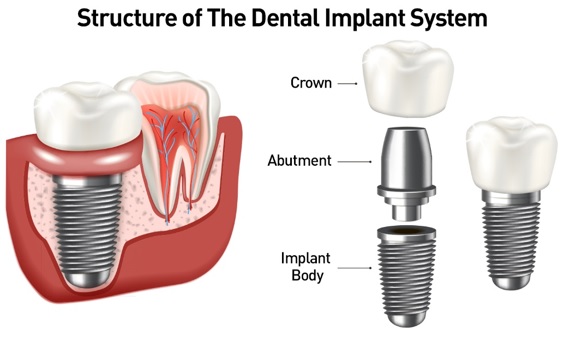5 Simple Techniques For Dental Implants
5 Simple Techniques For Dental Implants
Blog Article
Dental Implants for Beginners
Table of ContentsAbout Dental ImplantsThe 6-Minute Rule for Dental ImplantsThe Buzz on Dental ImplantsHow Dental Implants can Save You Time, Stress, and Money.
are medical gadgets operatively implanted right into the jaw to restore an individual's capacity to chew or their look. They provide assistance for synthetic (phony) teeth, such as crowns, bridges, or dentures. When a tooth is shed as a result of injury or disease, a person can experience difficulties such as rapid bone loss, defective speech, or modifications to eating patterns that cause pain.
Framework of The Dental Implant System choosing oral implants, speak to your dental service provider about the potential benefits and threats, and whether you are a candidate for the procedure. Things to think about: Your overall health is an essential element in identifying whether you are an excellent candidate for oral implants, for how long it will require to heal, and for how long the dental implant might remain in location.
Smoking may influence the healing procedure and reduce the long-lasting success of the implant. The healing process for the dental implant body might take numerous months or longer, throughout which time you generally have a momentary abutment instead of the tooth. the dental implant treatment: Meticulously comply with the dental hygiene guidelines offered to you by your oral company.
Dental Implants for Beginners
Implant failure can result in the requirement for an additional medical treatment to take care of or replace the implant system. Restores the ability to chew Brings back cosmetic appearance Aids maintain the jawbone from reducing because of bone loss Maintains the health of the surrounding bone and gum tissues Helps maintain adjacent (neighboring) teeth steady Boosts high quality of life Damages to surrounding natural teeth throughout implant placement Injury to the surrounding cells during surgical treatment, such as sinus perforation Injury during surgical treatment (as an example, fracture of surrounding jawbone) Poor feature, such as feeling like the teeth do not attack with each other normally A feeling that the tooth is loose or twisting in position arising from a joint screw loosening Implant body failing (looseness of the dental implant body) because of systemic infection, which may be more likely in individuals with unchecked diabetes due to neighborhood infection in bone and periodontals sustaining the implant body as a result of postponed healing, which may be most likely in individuals that smoke Trouble cleansing the gums around the dental implant, leading to inadequate oral hygiene Neglected gum illness Post-surgical pins and needles because of nerve impingement or damages Always alert healthcare suppliers and imaging specialists that you have oral implants prior to any type of magnetic resonance imaging (MRI) or x-ray procedures.
FDA is not conscious of any type of unfavorable events reported for MRI or x-ray treatments with oral implants. Dental implants systems are commonly made of products that follow international agreement requirements of the International Organization for Standardization (ISO) or ASTM International. These requirements have information of what makes a secure material.
Dental implant systems are evaluated according to worldwide agreement requirements. Biocompatibility testing, to show that bodily contact with the device does not trigger issues like inflammation or allergic response, is component of the evaluation that assists make certain the materials in the oral implant review system are risk-free and do not create adverse impacts when dental implanted in individuals.

The 10-Minute Rule for Dental Implants
Some individuals are not eligible for dental implant surgery. It is for dental doctors to run on people with: acute illnessuncontrollable metabolic diseasebone or soft cells condition or infectionIf these concerns are resolved, an individual can have the surgical procedure. Dental Implants. In, oral doctors avoid operating individuals with: If individuals with any of the above go through dental implant surgical procedure, there is a higher risk of the dental implant stopping working
Some individuals have a jawbone abnormality that prevents enough bone for a dental implant from creating. The cosmetic surgeon will certainly then make use of a bone or bone replacement to repair and develop up the area.
Dental pop over to this web-site dental implant surgical procedure is a personalized process. It's not the very same for every person. The following provides a basic overview of what you can expect your dental professional, dental specialist, periodontist or prosthodontist to do: Position the dental implant operatively. Offer you time to recover. Connect the message and last crown, bridge or denture.
Next off, your cosmetic surgeon will carefully place the dental implant into your jaw. Finally, your cosmetic surgeon will rearrange your gum tissues and close the incision with stitches. If your implant is near the front of your mouth, your dental practitioner will certainly make a temporary tooth for you to put on up until you heal. By doing this, you will not have a void in your smile while you recover.
Dental Implants Can Be Fun For Everyone
Your supplier can inform you what to anticipate in your scenario. Throughout the recovery phase, your jawbone ought to fuse to the oral implant. This procedure, called osseointegration, is important for stability and lasting success. This procedure can take anywhere from over here three to nine months. Sometimes, it may take much longer.
As soon as your implant heals, your dental professional can connect the abutment (tiny adapter message) and your final restoration (crown, bridge or denture). This usually takes regarding one hour to finish and may call for a 2nd small surgery. You should not really feel any type of pain throughout your oral implant procedure since your supplier will utilize medicine to numb your gums.
Report this page